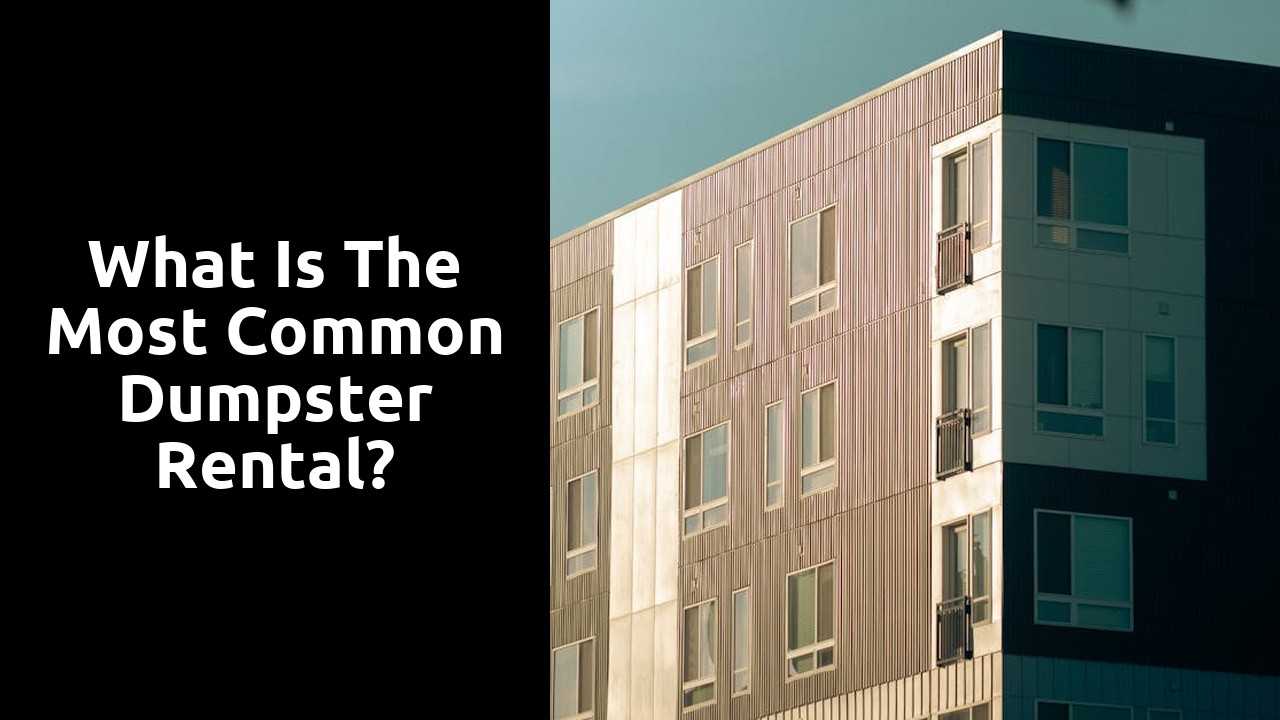What is the most common dumpster rental?

Table Of Contents
Permits Needed for Dumpster Rentals
When renting a dumpster, it is essential to consider whether a permit is necessary for your project. Many municipalities require permits, particularly for dumpsters placed on public property, such as streets or sidewalks. Homeowners should check local regulations to avoid potential fines or delays. Some areas may have specific size limitations or designated areas where dumpsters can be situated.
Understanding the permitting process can save time and ensure compliance with local laws. Application procedures often include submitting an application form along with a fee, and the turnaround time can vary. It is advisable to plan ahead to accommodate any time needed for permit approval, allowing for a seamless rental experience while keeping your project on schedule.
When and Why Permits Are Required
Many municipalities require permits for dumpster rentals, especially when the container will be placed on public property such as streets or sidewalks. These permits ensure that the placement complies with local regulations and safety standards. Obtaining a permit may involve filling out an application, paying a fee, and providing details regarding the project and the duration of the rental.
Permits are crucial for preventing potential hazards and ensuring that the Dumpster does not obstruct traffic or create safety issues for pedestrians. Even if a property owner plans to place the dumpster on private property, it is wise to verify local regulations, as some areas may still have specific guidelines regarding size, location, and rental duration.
Best Practices for Loading a Dumpster
Efficiently loading a dumpster can significantly enhance space utilization and make the disposal process smoother. Start by placing larger, heavier items on the bottom to create a stable base. This avoids shifting during transport and maximizes space utilization. Fill in gaps with smaller items or debris to ensure a compact load. Avoid overloading the dumpster beyond its weight limit, as this may result in additional fees or complications during pickup.
Organizing materials by type can simplify the unloading process. Consider separating recyclables, yard waste, and construction debris if the local waste management guidelines allow for it. To further optimize space, dismantle larger items whenever possible. Use proper lifting techniques and wear appropriate safety gear to prevent injury. Following these practices helps create a safer, more efficient loading experience, providing a more manageable and organized disposal solution.
Maximizing Space and Efficiency
When loading a dumpster, organization is key. Begin by breaking down large items. This will allow you to maximize the available space. Place heavier items at the bottom to create a solid base. As you stack lighter materials on top, ensure they are securely positioned to prevent them from toppling over. Arranging the materials in a strategic manner can significantly increase efficiency while keeping the load balanced.
Filling voids within the dumpster can also enhance space utilization. Use smaller items like bags of debris or loose materials to fill gaps between larger pieces. This practice not only optimizes space but also keeps the load stable during transport. Maintain an eye on the weight limit as well; overloading can lead to extra fees or complications. By adhering to these best practices, the rental experience can be more straightforward and productive.
Common Mistakes to Avoid with Dumpster Rentals
Underestimating the size of the dumpster needed is a frequent error. Renters often choose a smaller option to save money, only to find that it does not accommodate all their waste. This not only leads to additional costs for renting a second dumpster but also delays the disposal process. It's essential to accurately assess the volume of waste to avoid this inconvenience.
Another common mistake is overloading the dumpster beyond the weight limit. Each dumpster rental has specific weight restrictions, and exceeding these can result in hefty additional fees. It’s advisable to familiarize yourself with these limits and plan accordingly. Proper loading techniques, like distributing weight evenly, help ensure compliance while maximizing the available space.
Tips to Ensure a Smooth Experience
Planning ahead can significantly enhance the dumpster rental experience. Start by assessing the amount of waste you need to dispose of and choosing the right size dumpster. Having a clear estimate of the volume allows for selecting an appropriate container without overpaying or running out of space. It's also essential to consider delivery logistics, such as the location space for placement and access for the rental company, to prevent any last-minute inconveniences.
Communication with the rental service is vital. Inquire about any restrictions on materials that can be disposed of in the dumpster. Familiarize yourself with local regulations regarding waste disposal. This knowledge helps avoid fines or penalties that can arise from improper waste management. Lastly, ensuring that all parties involved are aware of the drop-off and pick-up schedules aids in maintaining the seamless flow of your project.
FAQS
What is the most common type of dumpster rental?
The most common type of dumpster rental is a 10 to 20-yard container, which is suitable for various residential projects, such as home renovations, cleanouts, and small construction jobs.
Do I need a permit for a dumpster rental?
It depends on your local regulations and where you plan to place the dumpster. If it’s on your property, a permit is often not required, but if it’s on public property or the street, a permit may be necessary.
How long can I keep a rented dumpster?
The rental period can vary by company, but typically you can keep a dumpster for 7 to 14 days. Some companies may offer flexible rental options based on your project needs.
What items are prohibited from being placed in a dumpster rental?
Common prohibited items include hazardous materials (like chemicals and batteries), electronics, tires, and appliances containing refrigerants. Always check with your rental company for specific restrictions.
What are some best practices for loading a dumpster?
To maximize space and efficiency, break down large items, distribute weight evenly, and avoid overfilling the dumpster. This helps ensure safe transport and compliance with regulations.